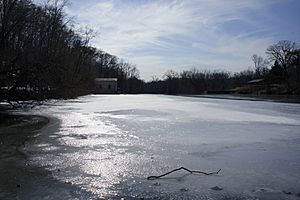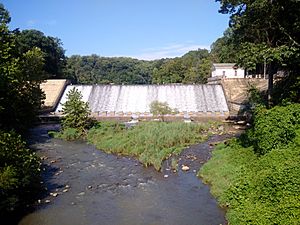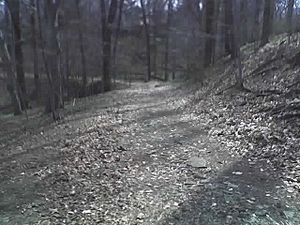Lake Roland (park) facts for kids
Quick facts for kids Lake Roland Park |
|
|---|---|
 |
|
| Location | 1000 Lakeside Drive Baltimore, MD 21210 |
| Area | 500 acres (200 ha) |
| Created | 1945 |
| Operated by | Baltimore City Department of Parks and Recreation |
|
Lake Roland Historic District
|
|
| Nearest city | Baltimore, Maryland |
|---|---|
| Area | 281 acres (114 ha) |
| Built | 1858 |
| Architect | Slade, James |
| Architectural style | Greek Revival |
| NRHP reference No. | 92001285 |
| Added to NRHP | October 15, 1992 |
Lake Roland Park is a large park covering over 500 acres in Baltimore County, Maryland. It's a beautiful place with forests, wetlands, and special rocky areas. The park surrounds Lake Roland and is easy to find near the Falls Road Light Rail Stop. The light rail even crosses over the lake on a bridge, splitting the park into two main parts.
Even though the park is just outside Baltimore city, the city owns it. For many years, Baltimore City managed the park. Later, Baltimore County took over running it. The park was closed for a while in 2009 for big renovations. It reopened in October 2011 with new playgrounds, trails, and even a dog park!
Contents
Discovering Lake Roland Park
Lake Roland Park is a fantastic place to explore nature and have fun outdoors. It has many different areas, from thick woodlands to peaceful wetlands. You can find rare plants and interesting rocky spots here. The park is a great example of how nature can thrive close to a city.
What You Can Do at the Park
The park offers lots of activities for visitors. You can hike on many trails, explore the nature center, or let your dog play at Paw Point Dog Park. There are also two pavilions for picnics and various programs about nature and the environment. Plus, you can enjoy activities on the waterfront!
The Lake Roland Nature Council works with local artists for an "Art on the Trail" project. This project started in 2015 and lets you see amazing artwork while enjoying the park's natural beauty.
The Story of Lake Roland
Lake Roland was created in the late 1850s. Back then, Baltimore City needed a better way to get water to its growing population. The city bought a private water company and decided to build this lake as a main water source.
Building the Lake and Water System
The old pumping station on the lake's eastern side was built around 1860-1861. It's made of marble and has a special stone with the names of the people who helped build it. This station was a key part of the city's new water system.
Around the same time, the city also bought the Druid Hill estate, which became Druid Hill Park. This park is one of the largest city parks in the country. Druid Lake was also created there to help store more water. A famous landscape architect named Frederick Law Olmsted helped design the system of parks and parkways for Baltimore. Lake Roland and its dam were an important part of his plans.
Lake Roland Historic District
In 1992, the area around Lake Roland was named a national historic district. This means it's a special place with important history. The district includes the lake, parts of the Jones Falls and Roland Run streams, and old railroad paths. The stone dam and valve house, built between 1858 and 1861, are central to this historic area. They show how important the lake was for Baltimore's water supply.

The Park's Name Change
For many years, the park was known as Robert E. Lee Memorial Park. It was named in 1945 after General Robert E. Lee, who led the Confederate army during the American Civil War. This naming came from a request by a wealthy Baltimore resident, Elizabeth B. Garrett White. She wanted money from her estate to be used for a monument to Lee, and it was decided to name the park instead.
Over time, some people felt the park's name was a reminder of a difficult past. They believed it didn't reflect the values of today. In 2015, after discussions about symbols from the Confederate era, there was a strong push to change the park's name.
Why the Name Changed
In June 2015, the County Executive of Baltimore County, Kevin Kamenetz, asked Baltimore City to change the name. He felt that "Lake Roland Park" would better represent this special natural area. On September 28, 2015, the Baltimore City Council approved the change, and the park was officially renamed Lake Roland. This new name helps the park focus on its natural beauty and history, rather than a controversial historical figure.




